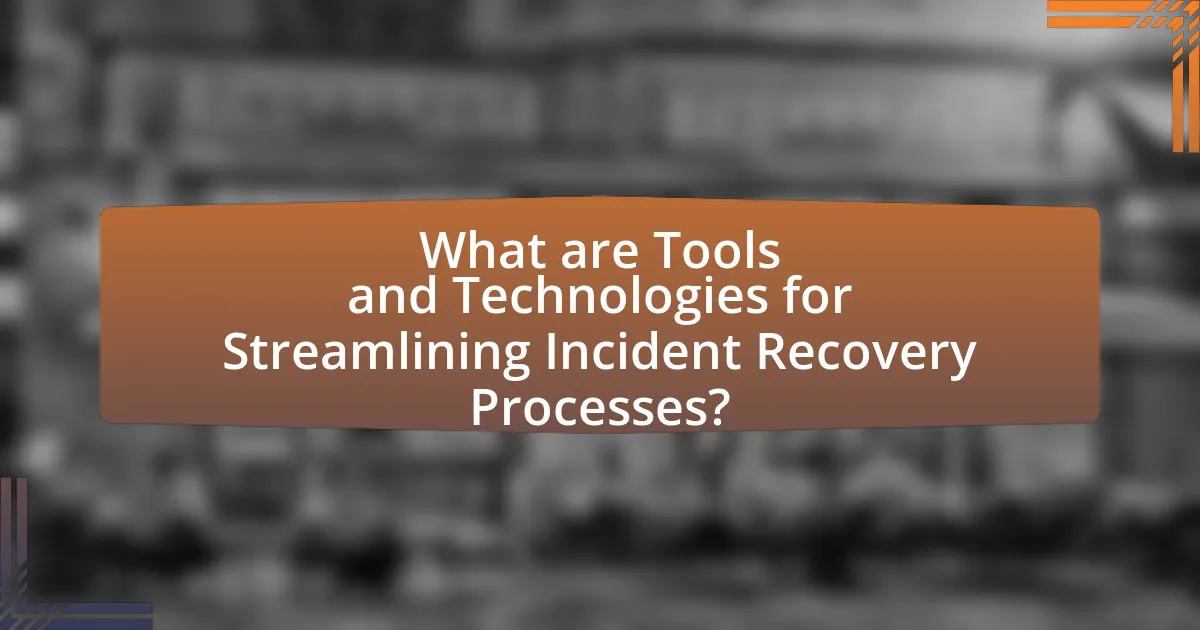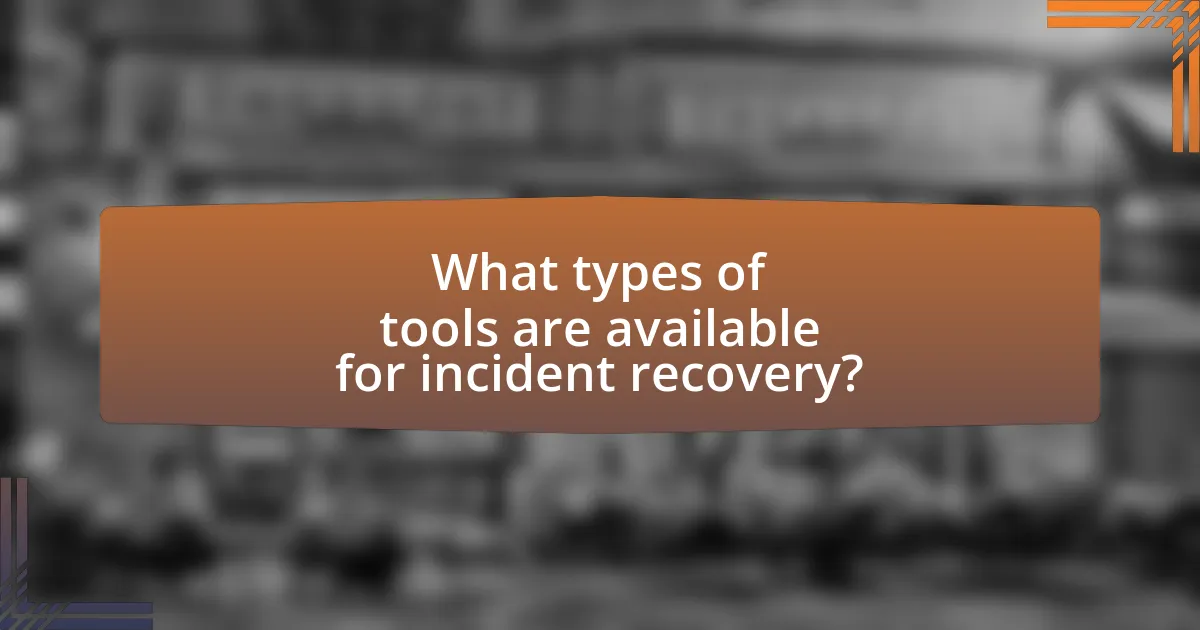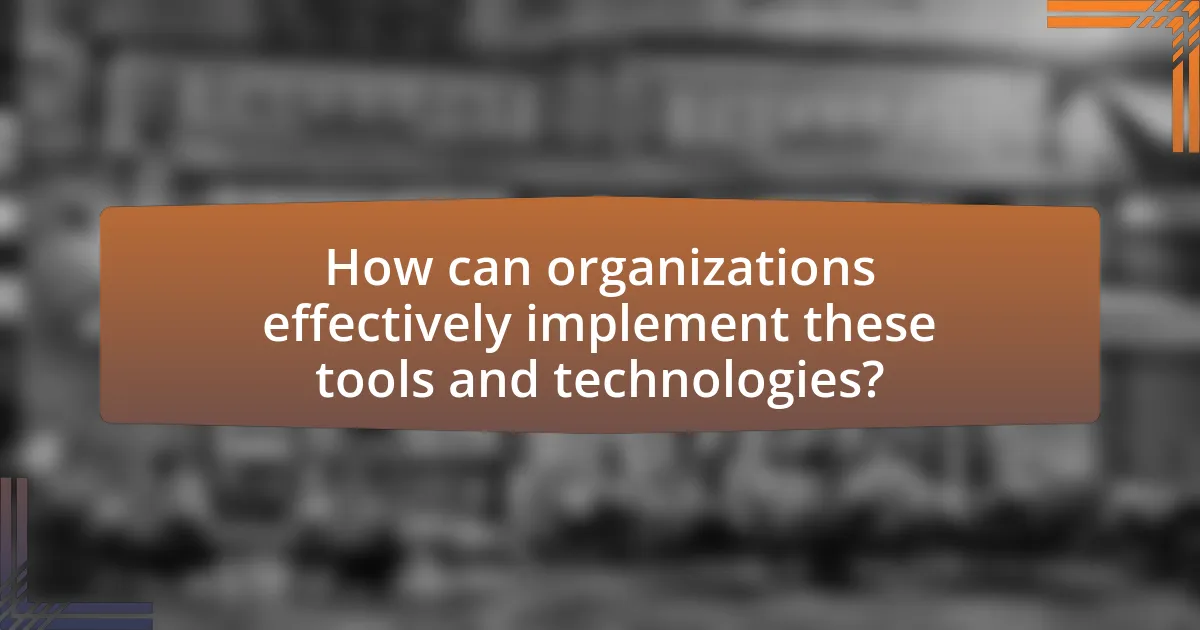The article focuses on tools and technologies designed to streamline incident recovery processes, highlighting the importance of incident management software, automation tools, and cloud-based recovery solutions. It discusses how these technologies function to enhance efficiency, improve communication, and reduce downtime during recovery efforts. Key components of incident recovery tools, such as backup capabilities and incident response planning, are examined, along with their interactions during recovery processes. The article also outlines the benefits of automation, the differences between automated and manual recovery methods, and strategies for effective implementation and continuous improvement in recovery practices.

What are Tools and Technologies for Streamlining Incident Recovery Processes?
Tools and technologies for streamlining incident recovery processes include incident management software, automation tools, and cloud-based recovery solutions. Incident management software, such as ServiceNow or Jira Service Management, enables organizations to track incidents, manage workflows, and facilitate communication among teams, thereby reducing recovery time. Automation tools like PagerDuty and Opsgenie help in alerting the right personnel quickly and automating repetitive tasks, which enhances response efficiency. Additionally, cloud-based recovery solutions, such as AWS Disaster Recovery and Microsoft Azure Site Recovery, provide scalable and flexible options for data backup and restoration, ensuring minimal downtime during incidents. These tools collectively improve the speed and effectiveness of incident recovery efforts, as evidenced by organizations reporting up to a 50% reduction in recovery time when implementing such technologies.
How do these tools and technologies function in incident recovery?
Tools and technologies function in incident recovery by automating and streamlining the processes necessary to restore systems and services after an incident. These tools, such as backup solutions, incident management software, and communication platforms, facilitate rapid data recovery, efficient resource allocation, and effective coordination among teams. For instance, automated backup systems ensure that data is regularly saved and can be quickly restored, minimizing downtime. Incident management software allows organizations to track incidents, prioritize responses, and analyze root causes, which enhances recovery strategies. Communication platforms enable real-time updates and collaboration, ensuring that all stakeholders are informed and can act swiftly. The integration of these technologies leads to a more resilient incident recovery framework, reducing recovery time and improving overall operational efficiency.
What are the key components of incident recovery tools?
The key components of incident recovery tools include backup and restore capabilities, incident response planning, monitoring and alerting systems, and documentation management. Backup and restore capabilities ensure that data can be recovered quickly after an incident, while incident response planning provides structured procedures for addressing various types of incidents. Monitoring and alerting systems facilitate real-time detection of issues, enabling swift action, and documentation management helps maintain records of incidents and recovery efforts for future reference and compliance. These components collectively enhance the effectiveness and efficiency of incident recovery processes.
How do these components interact during an incident recovery process?
During an incident recovery process, components such as incident response teams, recovery tools, and communication systems interact to restore normal operations efficiently. The incident response team assesses the situation and coordinates the recovery efforts, utilizing recovery tools like backup systems and restoration software to recover lost data and services. Communication systems facilitate real-time updates among team members and stakeholders, ensuring everyone is informed and aligned on recovery actions. This interaction is critical, as effective coordination and timely information sharing can significantly reduce downtime and mitigate the impact of the incident.
What are the primary benefits of using these tools and technologies?
The primary benefits of using tools and technologies for streamlining incident recovery processes include enhanced efficiency, improved communication, and reduced downtime. These tools automate repetitive tasks, allowing teams to focus on critical issues, which leads to faster recovery times. For instance, organizations that implement incident management software report a 30% reduction in recovery time, as documented in a study by the IT Service Management Forum. Additionally, these technologies facilitate real-time communication among stakeholders, ensuring that everyone is informed and aligned during recovery efforts, which minimizes confusion and errors.
How do they enhance efficiency in incident recovery?
Tools and technologies enhance efficiency in incident recovery by automating processes, facilitating real-time communication, and providing data analytics for informed decision-making. Automation reduces manual intervention, which speeds up recovery times and minimizes human error. Real-time communication tools ensure that all stakeholders are promptly informed, allowing for quicker response and coordination. Additionally, data analytics tools help identify patterns and root causes of incidents, enabling organizations to implement preventive measures and improve future recovery efforts. For instance, organizations using automated incident response platforms have reported up to a 50% reduction in recovery time, demonstrating the tangible benefits of these technologies.
What cost savings can organizations expect from implementing these solutions?
Organizations can expect significant cost savings from implementing tools and technologies for streamlining incident recovery processes, with estimates suggesting reductions of up to 30% in recovery costs. These savings arise from improved efficiency, reduced downtime, and minimized resource allocation during incident management. For instance, a study by the Ponemon Institute found that organizations utilizing automated recovery solutions experienced a 25% decrease in the time required to resolve incidents, directly correlating to lower operational costs. Additionally, companies that adopt these technologies often report a decrease in the frequency and severity of incidents, further contributing to long-term financial benefits.

What types of tools are available for incident recovery?
Incident recovery tools include backup and restore software, disaster recovery as a service (DRaaS), incident management systems, and data recovery tools. Backup and restore software, such as Veeam or Acronis, enables organizations to create copies of data for restoration after an incident. DRaaS solutions, like Zerto or AWS Disaster Recovery, provide cloud-based recovery options that ensure business continuity. Incident management systems, such as ServiceNow or PagerDuty, facilitate the tracking and resolution of incidents, while data recovery tools, like Recuva or EaseUS Data Recovery Wizard, help recover lost or corrupted data. These tools are essential for minimizing downtime and ensuring data integrity during recovery processes.
What are the differences between automated and manual recovery tools?
Automated recovery tools utilize predefined algorithms and scripts to restore systems or data with minimal human intervention, while manual recovery tools require direct human involvement for each step of the recovery process. Automated tools enhance efficiency by executing recovery tasks quickly and consistently, reducing the potential for human error, whereas manual tools offer flexibility and control, allowing for tailored recovery strategies based on specific situations. For instance, automated tools can restore data from backups in minutes, while manual recovery may take hours or days, depending on the complexity of the issue.
How does automation improve the recovery timeline?
Automation significantly improves the recovery timeline by accelerating response times and reducing human error during incident recovery processes. Automated systems can quickly identify issues, deploy fixes, and restore services without the delays associated with manual interventions. For instance, a study by the Ponemon Institute found that organizations using automation in their recovery processes experienced a 50% reduction in downtime compared to those relying solely on manual methods. This efficiency not only speeds up recovery but also enhances overall operational resilience.
What are the limitations of manual recovery processes?
Manual recovery processes are limited by their susceptibility to human error, which can lead to data loss or prolonged downtime. These processes often rely on individuals to execute recovery steps accurately, and mistakes can occur due to fatigue, oversight, or lack of training. Additionally, manual recovery is typically time-consuming, as it requires significant human intervention, which can delay the restoration of services. Furthermore, scalability is a challenge; as organizations grow, the complexity of manual recovery increases, making it difficult to manage effectively. According to a study by the Ponemon Institute, organizations that rely on manual processes experience an average recovery time that is 50% longer than those utilizing automated solutions, highlighting the inefficiency of manual methods.
Which technologies are most commonly used in incident recovery?
The most commonly used technologies in incident recovery include backup and recovery software, cloud storage solutions, and disaster recovery as a service (DRaaS). Backup and recovery software, such as Veeam and Acronis, enables organizations to create data backups and restore systems quickly after an incident. Cloud storage solutions, like Amazon S3 and Microsoft Azure, provide scalable and secure data storage options that facilitate rapid recovery. DRaaS offers comprehensive recovery solutions by replicating and hosting physical or virtual servers in a third-party data center, ensuring business continuity during incidents. These technologies are essential for minimizing downtime and ensuring data integrity during recovery processes.
What role does cloud computing play in incident recovery?
Cloud computing plays a critical role in incident recovery by providing scalable resources and rapid data access, which are essential for restoring operations after an incident. It enables organizations to back up data in real-time and deploy recovery solutions quickly, minimizing downtime. For instance, according to a report by Gartner, businesses utilizing cloud-based disaster recovery solutions can reduce recovery time objectives (RTO) by up to 90%. This efficiency is achieved through automated processes and the ability to access data from multiple locations, ensuring that recovery efforts are both swift and effective.
How do data backup solutions contribute to recovery efforts?
Data backup solutions significantly enhance recovery efforts by ensuring that critical data can be restored quickly and accurately after a loss event. These solutions create copies of data at regular intervals, allowing organizations to retrieve the most recent version of their information, which minimizes downtime and data loss. For instance, a study by the Ponemon Institute found that organizations with effective backup solutions can reduce recovery time by up to 50%, demonstrating the direct impact of these tools on operational resilience.

How can organizations effectively implement these tools and technologies?
Organizations can effectively implement tools and technologies for streamlining incident recovery processes by conducting a thorough needs assessment to identify specific requirements and gaps. This assessment allows organizations to select appropriate tools that align with their operational goals and incident recovery strategies. For instance, a study by the National Institute of Standards and Technology (NIST) emphasizes the importance of aligning technology with organizational objectives to enhance recovery efficiency. Furthermore, organizations should prioritize training and change management to ensure that staff are proficient in using the new tools, as effective training has been shown to improve adoption rates and operational performance. Regularly reviewing and updating these tools based on feedback and evolving needs also contributes to sustained effectiveness in incident recovery processes.
What steps should be taken to integrate incident recovery tools into existing systems?
To integrate incident recovery tools into existing systems, organizations should follow a structured approach that includes assessment, selection, implementation, testing, and training. First, conduct a thorough assessment of current systems to identify gaps and requirements for incident recovery. Next, select appropriate incident recovery tools that align with the identified needs, ensuring compatibility with existing infrastructure. After selection, implement the tools by configuring them to work seamlessly with current systems, which may involve customization or integration with other software. Following implementation, conduct rigorous testing to validate the functionality and effectiveness of the tools in real-world scenarios. Finally, provide comprehensive training for staff to ensure they are proficient in using the new tools, which is critical for successful incident recovery. This structured approach is supported by industry best practices, which emphasize the importance of each step in ensuring effective integration and operational resilience.
How can organizations assess their current incident recovery capabilities?
Organizations can assess their current incident recovery capabilities by conducting a comprehensive evaluation of their existing recovery plans, processes, and technologies. This assessment involves reviewing documentation, testing recovery procedures through simulations, and analyzing past incident responses to identify strengths and weaknesses. For example, organizations can utilize frameworks such as the Business Continuity Institute’s Good Practice Guidelines, which provide structured methodologies for evaluating recovery capabilities. Additionally, organizations can leverage metrics such as Recovery Time Objectives (RTO) and Recovery Point Objectives (RPO) to quantify their recovery performance and identify areas for improvement.
What training is necessary for staff to utilize these tools effectively?
Staff requires comprehensive training in the specific tools and technologies designed for streamlining incident recovery processes to utilize them effectively. This training should include hands-on workshops that cover the functionalities of the tools, best practices for incident management, and real-world scenarios to enhance problem-solving skills. Additionally, staff should receive training on data analysis techniques to interpret recovery metrics and performance indicators, ensuring they can make informed decisions during incidents. Evidence from industry standards, such as the ITIL framework, emphasizes the importance of structured training programs to improve operational efficiency and reduce recovery times.
What best practices should organizations follow when using incident recovery tools?
Organizations should implement a structured approach when using incident recovery tools to ensure effective recovery and minimize downtime. Best practices include regularly updating and testing recovery plans, which helps identify gaps and improve response times; training staff on the tools and processes, ensuring that all team members are familiar with their roles during an incident; and maintaining clear documentation of recovery procedures, which facilitates quick reference and adherence during crises. Additionally, organizations should integrate incident recovery tools with existing IT infrastructure to streamline workflows and enhance communication. According to a study by the Ponemon Institute, organizations that regularly test their recovery plans experience 50% less downtime during incidents, highlighting the importance of these practices.
How can regular testing of recovery processes improve outcomes?
Regular testing of recovery processes enhances outcomes by identifying weaknesses and ensuring preparedness for real incidents. This proactive approach allows organizations to refine their recovery strategies, minimizing downtime and data loss during actual events. For instance, a study by the Ponemon Institute found that organizations that conduct regular recovery tests experience 50% less downtime compared to those that do not. By simulating various scenarios, organizations can evaluate the effectiveness of their recovery plans, train personnel, and make necessary adjustments, ultimately leading to improved resilience and faster recovery times.
What metrics should be monitored to evaluate the effectiveness of these tools?
To evaluate the effectiveness of tools for streamlining incident recovery processes, key metrics to monitor include recovery time objective (RTO), recovery point objective (RPO), incident response time, and user satisfaction scores. RTO measures the time taken to restore systems after an incident, while RPO indicates the maximum acceptable data loss measured in time. Monitoring incident response time helps assess how quickly teams react to incidents, and user satisfaction scores provide insights into the perceived effectiveness of the tools. These metrics collectively offer a comprehensive view of the tools’ performance and their impact on incident recovery efficiency.
What common challenges do organizations face in incident recovery?
Organizations commonly face challenges in incident recovery such as inadequate planning, resource constraints, and communication breakdowns. Inadequate planning often leads to unpreparedness for incidents, resulting in prolonged recovery times. Resource constraints, including limited personnel and budget, hinder the ability to respond effectively and implement recovery strategies. Communication breakdowns can cause delays in information sharing and coordination among teams, further complicating recovery efforts. According to a report by the Disaster Recovery Institute International, 70% of organizations without a formal recovery plan experience significant delays in recovery, highlighting the critical need for comprehensive planning and resource allocation.
How can organizations overcome resistance to adopting new technologies?
Organizations can overcome resistance to adopting new technologies by fostering a culture of open communication and providing comprehensive training. By engaging employees in discussions about the benefits and implications of new technologies, organizations can address concerns and misconceptions directly. Research indicates that 70% of change initiatives fail due to employee resistance, highlighting the importance of involving staff in the transition process. Additionally, offering targeted training programs ensures that employees feel confident and competent in using new tools, which can significantly reduce anxiety and resistance.
What strategies can be employed to ensure continuous improvement in recovery processes?
To ensure continuous improvement in recovery processes, organizations should implement regular performance assessments, utilize data analytics for decision-making, and foster a culture of feedback and learning. Regular performance assessments allow teams to identify bottlenecks and inefficiencies, while data analytics provides insights into recovery trends and outcomes, enabling informed adjustments. Additionally, fostering a culture of feedback encourages team members to share experiences and suggestions, which can lead to innovative solutions and enhancements in recovery strategies. These approaches are supported by studies indicating that organizations employing data-driven decision-making and continuous feedback mechanisms experience higher efficiency and effectiveness in their recovery processes.
What practical tips can enhance the effectiveness of incident recovery tools?
To enhance the effectiveness of incident recovery tools, organizations should implement regular training and simulations for their teams. This practice ensures that personnel are familiar with the tools and can respond swiftly during actual incidents, thereby reducing recovery time. Additionally, integrating automated reporting features within these tools can streamline communication and provide real-time updates, which is crucial for effective decision-making. Research indicates that organizations that conduct regular training and utilize automation in incident recovery see a 30% improvement in response times, demonstrating the tangible benefits of these strategies.
